There are 8 stages and 160 kilometres that make up one of the most fascinating paths in Lombardy. The "Way of Charlemagne" takes its name from an ancient legend of the fifteenth century that narrates a journey undertaken by the sovereign from Pavia to Verona, passing through Lodi, Bergamo, the Cavallina Valley, the Borlezza Valley, Lovere, the Camonica Valley and the Tonale Pass.
On his journey, Charlemagne conquered the pagans’ castles and converted them to Christianity. To celebrate his victories, he built churches on the ruins of the destroyed castles. Among the disputed battles it is said that, at the Mortirolo Pass, he violently vanquished the Lombard troops.
Part of the journey can now be retraced through the Camino, starting from Bergamo, crossing the towns along the Serio river, the Argon valleys, the Cavallina Valley, the Borlezza Valley and finally arriving in the Camonica Valley. A varied and spectacular journey that unites cities, valleys, lakes and Alpine passes, between the territories of Bergamo and Brescia.
It starts from Piazza Duomo in Upper Bergamo at about 380 metres above sea level and arrives at Ponte di Legno at 1300 metres above sea level, near the Tonale Pass. The total altitude difference makes this route of medium difficulty, with some quite challenging climbs and descents.
Pilgrims can request and bring with them the Way of Charlemagne Credential, the document to be stamped at each stage necessary to certify the effective completion of the Way and obtain the Testimonium once completed.
For more information on the Way, on where to request the stamps and the Testimonium, visit the website https://www.camminodicarlomagno.it. To obtain the Credential, write to amiciviavaleriana@libero.it indicating: name and surname, how many of you will be walking along the path, city of residence and nationality.
STAGE 1 BERGAMO - SAN PAOLO D’ARGON
The first 19.5km will take you from the magnificent Piazza Duomo of Upper Bergamo to San Paolo d’Argon. Along the way you pass the Church of San Michele del Pozzo Bianco, with frescoes from the 13th century onwards, and then leave the city and immerse yourself in the vineyards and hills of Scanzorosciate and Torre dè Roveri. The stage ends in front of the Benedictine Abbey of San Paolo d’Argon.
STAGE 2 SAN PAOLO D’ARGON - SPINONE AL LAGO
The second stage, with its 22.8km, runs through the Cavallina Valley and ends on the wonderful Lake Endine. Starting from San Paolo d'Argon, you go up towards Cenate Sopra up to the Sanctuary of Santa Maria Assunta in Monte Mismalocated over 800 metres above sea level, and then go through several historic villages such as Luzzana, Borgo di Terzi and Vigano San Martino and skirt Lake Endine, where you first pass by the Castle of Monasterolo del Castello and finally reach the Church of San Pietro in Vincoli in Spinone al Lago.
STAGE 3 SPINONE AL LAKE - LOVERE
From Spinone al Lago you go up towards the panoramic Bianzano Castle and after passing through the small medieval village you reach the town of Ranzanico. Continue towards Sovere entering the Borlezza Valley and then go up to the Sanctuary of San Giovanni on Monte Cala and descend again to Lovere, one of the most beautiful villages in Italy, on the shores of Lake Iseo.
STAGE 4 LOVERE - DARFO BOARIO TERME
The last stop in the Bergamo area will take you from the Basilica of Santa Maria in Valvendra to the hamlets of Corti and Volpino in the municipality of Costa Volpino. Continue towards the town of Rogno and then cross over into the Brescia area, climbing up to admire Lake Moro and finally arriving at the Terme di Boario.
By showing the Credential at the entrance, access to the Thermal Park is free and the spa area can be used with a 20% discount.
There are 8 stages and 160 kilometres that make up one of the most fascinating paths in Lombardy. The "Way of Charlemagne" takes its name from an ancient legend of the fifteenth century that narrates a journey undertaken by the sovereign from Pavia to Verona, passing through Lodi, Bergamo, the Cavallina Valley, the Borlezza Valley, Lovere, the Camonica Valley and the Tonale Pass.
On his journey, Charlemagne conquered the pagans’ castles and converted them to Christianity. To celebrate his victories, he built churches on the ruins of the destroyed castles. Among the disputed battles it is said that, at the Mortirolo Pass, he violently vanquished the Lombard troops.
Part of the journey can now be retraced through the Camino, starting from Bergamo, crossing the towns along the Serio river, the Argon valleys, the Cavallina Valley, the Borlezza Valley and finally arriving in the Camonica Valley. A varied and spectacular journey that unites cities, valleys, lakes and Alpine passes, between the territories of Bergamo and Brescia.
It starts from Piazza Duomo in Upper Bergamo at about 380 metres above sea level and arrives at Ponte di Legno at 1300 metres above sea level, near the Tonale Pass. The total altitude difference makes this route of medium difficulty, with some quite challenging climbs and descents.
Pilgrims can request and bring with them the Way of Charlemagne Credential, the document to be stamped at each stage necessary to certify the effective completion of the Way and obtain the Testimonium once completed.
For more information on the Way, on where to request the stamps and the Testimonium, visit the website https://www.camminodicarlomagno.it. To obtain the Credential, write to amiciviavaleriana@libero.it indicating: name and surname, how many of you will be walking along the path, city of residence and nationality.
STAGE 1 BERGAMO - SAN PAOLO D’ARGON
The first 19.5km will take you from the magnificent Piazza Duomo of Upper Bergamo to San Paolo d’Argon. Along the way you pass the Church of San Michele del Pozzo Bianco, with frescoes from the 13th century onwards, and then leave the city and immerse yourself in the vineyards and hills of Scanzorosciate and Torre dè Roveri. The stage ends in front of the Benedictine Abbey of San Paolo d’Argon.
STAGE 2 SAN PAOLO D’ARGON - SPINONE AL LAGO
The second stage, with its 22.8km, runs through the Cavallina Valley and ends on the wonderful Lake Endine. Starting from San Paolo d'Argon, you go up towards Cenate Sopra up to the Sanctuary of Santa Maria Assunta in Monte Mismalocated over 800 metres above sea level, and then go through several historic villages such as Luzzana, Borgo di Terzi and Vigano San Martino and skirt Lake Endine, where you first pass by the Castle of Monasterolo del Castello and finally reach the Church of San Pietro in Vincoli in Spinone al Lago.
STAGE 3 SPINONE AL LAKE - LOVERE
From Spinone al Lago you go up towards the panoramic Bianzano Castle and after passing through the small medieval village you reach the town of Ranzanico. Continue towards Sovere entering the Borlezza Valley and then go up to the Sanctuary of San Giovanni on Monte Cala and descend again to Lovere, one of the most beautiful villages in Italy, on the shores of Lake Iseo.
STAGE 4 LOVERE - DARFO BOARIO TERME
The last stop in the Bergamo area will take you from the Basilica of Santa Maria in Valvendra to the hamlets of Corti and Volpino in the municipality of Costa Volpino. Continue towards the town of Rogno and then cross over into the Brescia area, climbing up to admire Lake Moro and finally arriving at the Terme di Boario.
By showing the Credential at the entrance, access to the Thermal Park is free and the spa area can be used with a 20% discount.
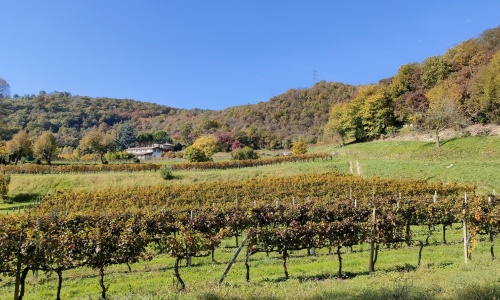
I primi 19,5 km vi condurranno dalla magnifica Piazza Duomo di Bergamo Alta a San Paolo d’Argon. Lungo il percorso si passa per la Chiesa di San Michele del Pozzo Bianco, con affreschi dal XIII secolo in poi, per poi uscire dalla città e immergersi nei vigneti e nelle colline di Scanzorosciate e Torre dè Roveri. La tappa termina davanti all’Abbazia benedettina di San Paolo d’Argon.
I primi 19,5 km vi condurranno dalla magnifica Piazza Duomo di Bergamo Alta a San Paolo d’Argon. Lungo il percorso si passa per la Chiesa di San Michele del Pozzo Bianco, con affreschi dal XIII secolo in poi, per poi uscire dalla città e immergersi nei vigneti e nelle colline di Scanzorosciate e Torre dè Roveri. La tappa termina davanti all’Abbazia benedettina di San Paolo d’Argon.
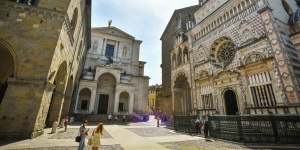
The religious heart of the city owes its name to the impressive cathedral that overlooks it, situated opposite the baptistery, the bishop's palace and the Curia.
Before the Venetian Republic created what is known today as Piazza Vecchia, this was the city’s medieval square, dedicated to St. Vincent, and the centre of the city and political life where decrees were announced, deeds were written and trades and negotiations took place.
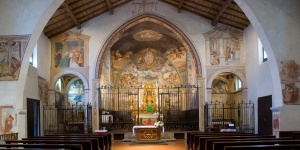
Did you know that the famous Renaissance artist Lorenzo Lotto lived in the House of the Vicar, next to this church? Today the house partially belongs to the Ursuline sisters pension; also due to this favourable position, the Venetian Master created some wonderful artworks in the San Michele al Pozzo bianco Church, including the cycle of frescoes depicting the Episodes of Mary’s Life, painted in 1525 in the left side chapel.
If you love art, this church is a real treasure chest: in fact, it hosts some of the most ancient frescoes in Bergamo’s territory and represents an outstanding “lesson” of the local painting history, ranging from the early XIII Century to the late XVI.
The round stone you can now see on the churchyard marks the place where the ancient white well used to be, giving the name to the church itself.
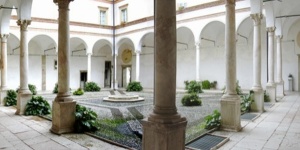
Entering the Abbey, you will encounter a delightful little Renaissance cloister, decorated in terracotta and with finely inlaid column capitals, most likely by Pietro Isabello, the greatest Bergamasco architect of the time. Certainly his, is the refectory of 1536, frescoed in 1624 by the Veronese Giovanni Battista Lorenzetti. The second cloister is much wider, with 32 columns arranged in a rectangular plan.
The Church is a wonderful example of seventeenth-century style, starting from the marble facade; crossing the threshold, the majestic nave awaits you with its six side chapels, many paintings by the most important artists of the period and inlaid marble altars.
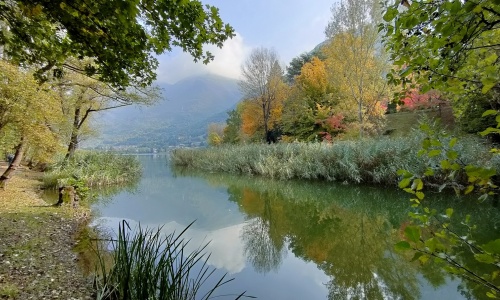
La seconda tappa, con i suoi 22,8 km, percorre la Val Cavallina e si conclude sul meraviglioso Lago d’Endine: partendo da San Paolo d’Argon, si sale verso Cenate Sopra fino al Santuario di Santa Maria Assunta in Monte Misma situato oltre gli 800 metri slm, per poi attraversare diversi borghi storici come Luzzana, Borgo di Terzi e Vigano San Martino e costeggiare il Lago d’Endine, dove si passa prima dal Castello di Monasterolo del Castello e si raggiunge infine dalla Chiesa di San Pietro in Vincoli a Spinone al Lago.
La seconda tappa, con i suoi 22,8 km, percorre la Val Cavallina e si conclude sul meraviglioso Lago d’Endine: partendo da San Paolo d’Argon, si sale verso Cenate Sopra fino al Santuario di Santa Maria Assunta in Monte Misma situato oltre gli 800 metri slm, per poi attraversare diversi borghi storici come Luzzana, Borgo di Terzi e Vigano San Martino e costeggiare il Lago d’Endine, dove si passa prima dal Castello di Monasterolo del Castello e si raggiunge infine dalla Chiesa di San Pietro in Vincoli a Spinone al Lago.
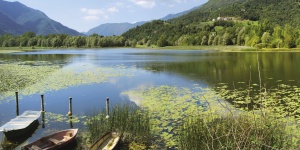
Lake Endine is a small yet beautiful jewel: its 14 kilometers-long shores are crossed by rushing creeks going down from the surrounding mountains.
The natural environment hasn’t changed much over the time, to the extent that it became an area protected by Lombardy Region: the green landscape is just breath-taking!
Canebrakes, shores, meadows: a mosaic of enchanting places you can visit going on foot or by bike.
Just a few kilometers North-East from here there is an amazing surprise, as well: another terrific small lake, called Gaiano.
In the summertime you can practice many sports such as sailing, windsurfing, canoeing, rowing and fishing.
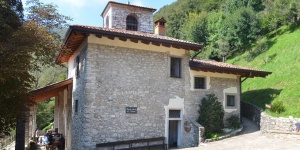
Located on the southern slope of Mount Misma, in the municipal territory of Cenate Sopra, the Church of Santa Maria Assunta di Misma is a fascinating sacred site built around the year one thousand.
A Romanic jewel straddling the Seriana Valley and the Cavallina Valley, reachable only on foot following the red and white signs for the Italian Alpine Club path 607.
The Romanesque architecture of the church is very simple. There is a small bell tower next to a single rectangular room, which has a portico on its exterior, built on the side façade.
The interior of the church is characterised by three arches with small semi-circular apses that divide it into four bays, the last of which encloses the altar located in a central position.
Adjacent to the church there are two hostels, where you can stay for one night.
It can be visited on Sundays and public holidays, with free admission.
You can book tours for large groups.
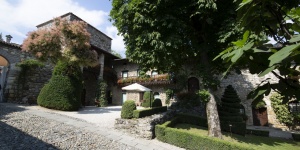
Located in Monasterolo del Castello, on Lake Endine, in the Cavallina Valley, 30km from Bergamo and just 10 minutes by car from Trescore Balneario, a town famous for its thermal baths and Villa Suardi with frescoes by Lorenzo Lotto.
On a small hill between the southern end of Lake Endine and the left bank of the Cherio river, the origins of the castle are controversial: according to tradition, before the castle, a Benedictine monastery stood on the hill, which was destroyed at the time of Charlemagne and never rebuilt. A fort was built around the year one thousand to provide protection for the local population. In the Renaissance, it became a prestigious residence losing its military value, but from the 18th century until the first decades of the last century the castle experienced a period of decline.
In the thirties, Duchess Winifred fell madly in love with the lake and bought the castle, beginning the restoration work that led to the recovery of the interiors and gardens.
Today Monasterolo Castle is owned by the Acquaroli group and is the perfect location for organising weddings and receptions.
The park is one of the most important in Northern Italy and is a botanical garden, in fact you can find over seven hundred tree species.
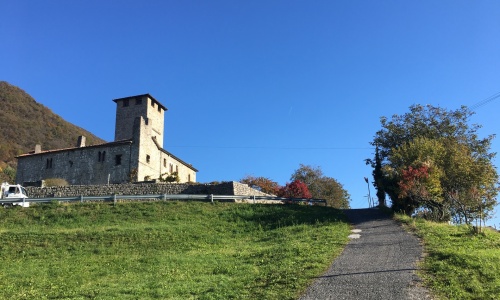
Da Spinone al Lago si sale verso il panoramico Castello di Bianzano e dopo aver attraversato il piccolo borgo medievale si raggiunge la località di Ranzanico. Si prosegue verso Sovere entrando nella Val Borlezza per poi salire verso il Santuario di San Giovanni sul Monte Cala e scendere nuovamente fino a Lovere, uno dei borghi più belli d’Italia, sulle rive del Lago d’Iseo.
Da Spinone al Lago si sale verso il panoramico Castello di Bianzano e dopo aver attraversato il piccolo borgo medievale si raggiunge la località di Ranzanico. Si prosegue verso Sovere entrando nella Val Borlezza per poi salire verso il Santuario di San Giovanni sul Monte Cala e scendere nuovamente fino a Lovere, uno dei borghi più belli d’Italia, sulle rive del Lago d’Iseo.
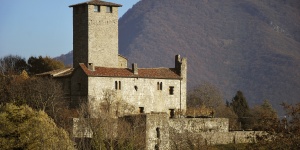
A lion rampant and an eagle with big talons grasping its prey represent the symbol of the ancient and noble Suardi family, depicted on the entry portal of Bianzano Castle.
The historical complex, dating back to the XIII Century, features a perfectly square plan whose diagonal lines indicate the cardinal points.
Located on a tableland overlooking the western side of the Cavallina Valley, the building allowed to control the north-western and north-eastern faces, from where the enemies could arrive: the road coming from the Seriana Valley across the Valle Rossa (the “Red Valley”) and the one connecting Bergamo with Lake Iseo and the Camonica Valley. It also provided a good view over Lake Endine and the Mount Torrezzo.
The numerical proportions and the symbols disseminated all over the castle lead one to think that, originally, it was a seat of the Templars, the knights belonging to the medieval religious order: would you like to learn more about it?
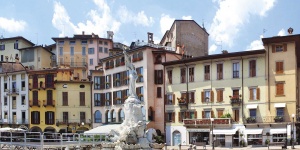
Lovere is a magical place: the best way to start visiting it is the lakefront road! ù
Its modern architectural layout enhances its natural beauty, making it a perfect location to enjoy both the lake view and the amazing facades of the town’s historical buildings.
It’s also a great place to relax or enjoy a delicious local meal: don’t miss the excellent fresh fish!
Explore the art and culture of this village by admiring the beautiful paintings and statues of the Accademia Tadini. If you’re more into science, go visit the collections of the Museo Civico Amighetti.
What’s the best way to finish your day in Lovere? A romantic sunset on the lakeside.
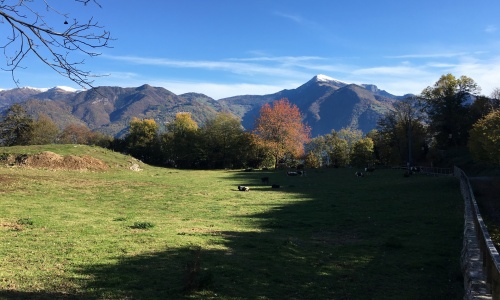
L’ultima tappa in territorio bergamasco vi condurrà dalla Basilica di Santa Maria in Valvendra alle frazioni di Corti e di Volpino nel comune di Costa Volpino. Si prosegue verso il paese di Rogno per poi sconfinare in territorio bresciano, salendo ad ammirare il Lago Moro e arrivando infine alle Terme di Boario.
Mostrando la Credenziale all’ingresso, l’accesso al Parco delle Terme è gratuito e il percorso SPA è fruibile con il 20% di sconto.
Il Cammino prosegue poi con altre 4 tappe...scoprile su https://www.camminodicarlomagno.it/tappe/
L’ultima tappa in territorio bergamasco vi condurrà dalla Basilica di Santa Maria in Valvendra alle frazioni di Corti e di Volpino nel comune di Costa Volpino. Si prosegue verso il paese di Rogno per poi sconfinare in territorio bresciano, salendo ad ammirare il Lago Moro e arrivando infine alle Terme di Boario.
Mostrando la Credenziale all’ingresso, l’accesso al Parco delle Terme è gratuito e il percorso SPA è fruibile con il 20% di sconto.
Il Cammino prosegue poi con altre 4 tappe...scoprile su https://www.camminodicarlomagno.it/tappe/
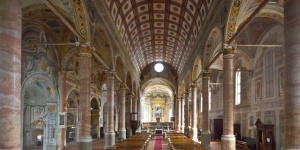
In Lovere we find the largest church in the Diocese of Brescia: The Santa Maria in Valvendra Basilica. The Basilica is located just outside the historic village of Lovere.
The church was intended as a votive shrine dedicated to the Our Lady of Graces by the families of Lovere and for the construction it was necessary to divert the Valvendra stream, from which it takes its name.
With a Gothic-Renaissance imprint, the exterior has a simple façade, preceded by a portico with 33 descending steps, symbolising the age of Jesus, and the interior is fascinating and majestic, completely frescoed.
There are numerous frescoes dedicated to the Trinity, painted in 1580, to St. Joseph and the Immaculate Conception painted in 1544 and in 1535 by Andrea da Manerbio and, finally, the paintings of the chapel of San Francesco, by Gian Giacomo Barbelli in 1647.
The organ is a fundamental part of the Basilica and is characterised by the doors painted by Floriano Ferramola with "The Annunciation" outside and inside you can admire the fresco of Saints Faustino and Giovita by Alessandro Bonvicino, called the Moretto.
The main marble altar was created by Andrea Fantoni. There is also a beautiful bell tower standing tall next to the church’s apse.
Free entrance.